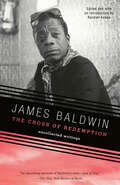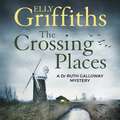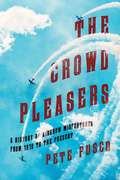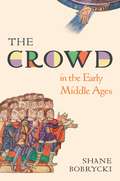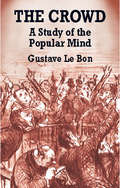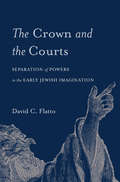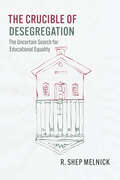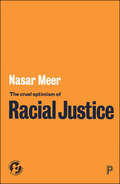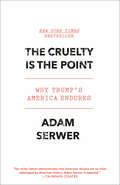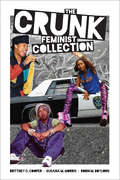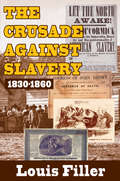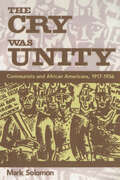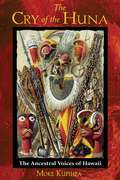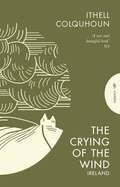- Table View
- List View
The Cross of Redemption: Uncollected Writings (Vintage International Ser.)
by James BaldwinFrom one of the most brilliant and provocative literary figures of the past century—a collection of essays, articles, reviews, and interviews that have never before been gathered in a single volume.&“An absorbing portrait of Baldwin&’s time—and of him.&” —New York Review of BooksJames Baldwin was an American literary master, renowned for his fierce engagement with issues haunting our common history. In The Cross of Redemption we have Baldwin discoursing on, among other subjects, the possibility of an African-American president and what it might mean; the hypocrisy of American religious fundamentalism; the black church in America; the trials and tribulations of black nationalism; anti-Semitism; the blues and boxing; Russian literary masters; and the role of the writer in our society.Prophetic and bracing, The Cross of Redemption is a welcome and important addition to the works of a cosmopolitan and canonical American writer who still has much to teach us about race, democracy, and personal and national identity. As Michael Ondaatje has remarked, &“If van Gogh was our nineteenth-century artist-saint, Baldwin [was] our twentieth-century one.&”
The Cross-Border Connection: Immigrants, Emigrants, and Their Homelands
by Roger WaldingerInternational migration presents the human face of globalization. Roger Waldinger addresses a paradox at its core: emigrants departing one society become immigrants in another, tying those two societies together. He explains how interconnections between place of origin and destination are built and maintained and why they eventually fall apart.
The Cross-Cultural Practice of Clinical Case Management in Mental Health (Haworth Social Work Practice Ser.)
by Peter ManoleasDiscover a culturally competent model of clinical case management in mental health practice settings. In The Cross-Cultural Practice of Clinical Case Management, author Peter Manoleas synthesizes some of the existent thinking on case management in cross-cultural psychotherapy settings and develops an effective model of clinical case management for mental health practitioners. The person-in-environment approach leads mental health professionals to realize that case managers and their clients must deal with a variety of cultures within the treatment environment. Rehabilitation programs, substance abuse programs, public assistance, the police, and especially psychiatry itself, are each characterized by their own 'cultures.’These may, at times, conflict with or present significant dissonance with the client's own ethnic culture. The Cross-Cultural Practice of Clinical Case Management advocates that the role of “culture broker” be added to the list of activities for effective clinical case managers. Several of the major ethnic groups represented in public mental health populations are examined, as well as other topics relevant to the daily practice of mental health professionals: Effective cross-cultural crisis intervention The culture of homelessness Women and the mental health system Asians and Pacific Islanders Latinos African Americans Native Americans Seriously Emotionally Disturbed ChildrenThe Cross-Cultural Practice of Clinical Case Management is of interest to practicing mental health professionals in the public sector as those systems convert from individual therapy to case management models of service delivery. Increasing numbers of ethnic minorities in public systems and the emphasis on cultural competence will make all of the topics of interest to many readers.
The Crossing Places: The Dr Ruth Galloway Mysteries 1 (The Dr Ruth Galloway Mysteries #1)
by Elly GriffithsA child's bones are discovered near the site of a pre-historic henge on the north Norfolk coast, and the police ask local forensic archaeologist Ruth Galloway to date them. Are these the remains of a local girl who disappeared ten years ago? DCI Harry Nelson refuses to give up the hunt for this missing child. Ever since she vanished, someone has been sending him bizarre anonymous notes about ritual sacrifice, quoting Shakespeare and the Bible. He knows Ruth's instincts and experience can help him finally put this case to rest. Then a second child goes missing, and Ruth finds herself in danger from a killer who knows she's getting ever closer to the truth...(P)2010 Quercus Editions Ltd
The Crossing Places: The Dr Ruth Galloway Mysteries 1 (The Dr Ruth Galloway Mysteries #1)
by Elly GriffithsStart right here! Discover the Dr Ruth Galloway Mysteries and become obsessed with one of the most popular crime series in Britain.'Galloway now seems as real as Marple and Morse' The Times'I've never before read a crime novel in which archaeology and detection blend as successfully as in The Crossing Places' ShotsDr Ruth Galloway is called in when a child's bones are discovered near a prehistoric site on the north Norfolk salt marshes. Are they the remains of a local girl who disappeared ten years earlier - or are the bones much older?DCI Harry Nelson refuses to give up the hunt for the missing girl. Since she vanished, someone has been sending him creepy anonymous notes about ritual sacrifice. He knows that Ruth's expertise and experience could help him finally to put this case to rest. But when a second child goes missing, Ruth finds herself in danger from a killer who knows she's getting ever closer to the truth.'Captivating! A quick, thrilling read that ends making you want to read Book 2 immediately!' 5* READER REVIEW'I really enjoyed this book, the story kept me gripped to the end! Would definitely recommend it' 5* READER REVIEW'Ruth is such an empathetic character, clever and warm yet she has human weaknesses' 5* READER REVIEW'I envy those coming of the Ruth Galloway series by Elly Griffiths. They are in for a total treat' 5* READER REVIEW'Atmospheric and character-driven, I'd no sooner finished this first book in the Dr Ruth Galloway series than I was reaching for the second' 5* READER REVIEW
The Crossing Places: The first book in the megaselling Ruth Galloway series (The Dr Ruth Galloway Mysteries #1)
by Elly GriffithsStart right here! Discover the Dr Ruth Galloway Mysteries and become obsessed with one of the most popular crime series in Britain.'Galloway now seems as real as Marple and Morse' The TimesDr Ruth Galloway is called in when a child's bones are discovered near a prehistoric site on the north Norfolk salt marshes. Are they the remains of a local girl who disappeared ten years earlier - or are the bones much older?DCI Harry Nelson refuses to give up the hunt for the missing girl. Since she vanished, someone has been sending him creepy anonymous notes about ritual sacrifice. He knows that Ruth's expertise and experience could help him finally to put this case to rest.But when a second child goes missing, Ruth finds herself in danger from a killer who knows she's getting ever closer to the truth.**************************************What readers are saying about The Crossing Places'Captivating! A quick, thrilling read that ends making you want to read Book 2 immediately!' 5* Reader Review 'I really enjoyed this book, the story kept me gripped to the end! Would definitely recommend it' 5* Reader Review'Ruth is such an empathetic character, clever and warm yet she has human weaknesses' 5* Reader Review'I envy those coming to the Ruth Galloway series by Elly Griffiths. They are in for a total treat' 5* Reader Review'Atmospheric and character-driven, I'd no sooner finished this first book in the Dr Ruth Galloway series than I was reaching for the second' 5* Reader Review
The Crossing: El Paso, the Southwest, and America's Forgotten Origin Story
by Richard ParkerA radical work of history that re-centers the American story around El Paso, Texas, gateway between north and south, center of indigenous power and resistance, locus of European colonization of North America, centuries-long hub of immigration, and underappreciated modern blueprint for a changing United States.American history is almost always told from East to West. Yet a closer look at the past reveals the country’s start began not in the East, but in the West—at a Texan city situated in a natural shallow crossing of the Rio Grande River: El Paso.El Paso is the crossroads of Indigenous America, the nexus of a thousand-year-old Native American migration and trade route, linking MesoAmerican and Pueblo empires and beyond. It’s where the European conquest of North America began, and where the United States’ Manifest Destiny was later achieved. Here, East met West, where the consequential transatlantic route, the Southern Pacific, was completed in 1881. Here the West was “won”—the Indian Wars were not fought on the Great Plains, but in the Southwest, with a scorched-earth strategy that went on for decades. It’s where Immigrant America starts—more immigrants have passed through El Paso than Ellis Island—and where crucial battles for Civil Rights were fought—the city smashing through racial and ethnic discrimination before anywhere else in the nation. The Crossing is a revelatory new history of El Paso that recasts the city as the unacknowledged cradle of American history, where cultures have encountered each other for centuries and forged a thriving multi-ethnic community far ahead of the rest of the nation. As award-winning, El Paso–native journalist Richard Parker charts, the city holds not only the framework of our American story, but also a model for a more diverse and flourishing country.
The Crossing: My journey to the shattered heart of Syria
by Samar Yazbek'ONE OF THE FIRST POLITICAL CLASSICS OF THE 21st CENTURY'- Observer'EXTRAORDINARILY POWERFUL, POIGNANT AND AFFECTING. I WAS GREATLY MOVED' Michael PalinFOREWORD BY CHRISTINA LAMBJournalist Samar Yazbek was forced into exile by Assad's regime. When the uprising in Syria turned to bloodshed, she was determined to take action and secretly returned several times. The Crossing is her rare, powerful and courageous testament to what she found inside the borders of her homeland.From the first peaceful protests for democracy to the arrival of ISIS, she bears witness to those struggling to survive, to the humanity that can flower amidst annihilation, and why so many are now desperate to flee.
The Crowd Pleasers: A History of Airshow Misfortunes from 1910 to the Present
by Peter FuscoAn adventure-filled romp through one of aviation’s most notable, dangerous and entertaining pursuits: airshows! In the early days of aviation, all flights were airshows. Spectators gathered whenever a new flying machine attempted to leave the ground—the trick was to get them to pay. Takeoffs and landings did not sell tickets but people lined up, money in hand, to watch a “dip of death,” in which an aviator would dive from as high as he or she dared and pull up at the last second. Risk always sells and flying was man’s riskiest endeavor yet. From the start the “exhibition pilots” stood out. Everything about an aerobatic routine requires a degree of skill and a commitment to practice inconceivable to even most pilots, presenting innumerable risks to life and limb. And with risk, often, comes tragedy. The Crowd Pleasers is a sweeping history of air show accidents beginning in 1910 with the death of Charles Rolls, co-founder of Rolls-Royce, and ending in the present day. It brings to light some of the most notable air show accidents of all time and explores the aviators behind them. Their stories, their motivations. In so doing, it illuminates the role played by choice, social circumstance and fate in these often devastating accidents, and the lives attached to them. A must-read for all aviation buffs.
The Crowd in the Early Middle Ages (Histories of Economic Life)
by Dr. Shane BobryckiThe importance of collective behavior in early medieval EuropeBy the fifth and sixth centuries, the bread and circuses and triumphal processions of the Roman Empire had given way to a quieter world. And yet, as Shane Bobrycki argues, the influence and importance of the crowd did not disappear in early medieval Europe. In The Crowd in the Early Middle Ages, Bobrycki shows that although demographic change may have dispersed the urban multitudes of Greco-Roman civilization, collective behavior retained its social importance even when crowds were scarce.Most historians have seen early medieval Europe as a world without crowds. In fact, Bobrycki argues, early medieval European sources are full of crowds—although perhaps not the sort historians have trained themselves to look for. Harvests, markets, festivals, religious rites, and political assemblies were among the gatherings used to regulate resources and demonstrate legitimacy. Indeed, the refusal to assemble and other forms of &“slantwise&” assembly became a weapon of the powerless. Bobrycki investigates what happened when demographic realities shifted, but culture, religion, and politics remained bound by the past. The history of crowds during the five hundred years between the age of circuses and the age of crusades, Bobrycki shows, tells an important story—one of systemic and scalar change in economic and social life and of reorganization in the world of ideas and norms.
The Crowd: A Study of the Popular Mind
by Gustave Le BonOne of the most influential works of social psychology in history, The Crowd was highly instrumental in creating this field of study by analyzing, in detail, mass behavior. The book had a profound impact not only on Freud but also on such twentieth-century masters of crowd control as Hitler and Mussolini — both of whom may have used its observations as a guide to stirring up popular passions. In the author's words, "The masses have never thirsted after the truth. Whoever can supply them with illusions is easily their master; whoever attempts to destroy their illusions is always their victim."Although the volume focuses on crowd psychology, it is also brilliantly instructive on the effects of the generally accepted beliefs of a nation's citizenry on the processes of history. Among the topics covered here are general characteristics and mental unity of the crowd; the crowd's sentiments and morality; its ideas, reasoning power, and imagination; opinions and beliefs of crowds and the means used by leaders to persuade; classification of crowds, including criminal and electrical assemblages, as well as the functioning of criminal juries and parliamentary assemblies.A must-read volume for students of history, sociology, law, and psychology, The Crowd will also be invaluable to politicians, statesmen, investors, and marketing managers.
The Crown and the Courts: Separation Of Powers In The Early Jewish Imagination
by David C. FlattoA scholar of law and religion uncovers a surprising origin story behind the idea of the separation of powers.The separation of powers is a bedrock of modern constitutionalism, but striking antecedents were developed centuries earlier, by Jewish scholars and rabbis of antiquity. Attending carefully to their seminal works and the historical milieu, David Flatto shows how a foundation of democratic rule was contemplated and justified long before liberal democracy was born.During the formative Second Temple and early rabbinic eras (the fourth century BCE to the third century CE), Jewish thinkers had to confront the nature of legal authority from the standpoint of the disempowered. Jews struggled against the idea that a legal authority stemming from God could reside in the hands of an imperious ruler (even a hypothetical Judaic monarch). Instead scholars and rabbis argued that such authority lay with independent courts and the law itself. Over time, they proposed various permutations of this ideal. Many of these envisioned distinct juridical and political powers, with a supreme law demarcating the respective jurisdictions of each sphere. Flatto explores key Second Temple and rabbinic writings—the Qumran scrolls; the philosophy and history of Philo and Josephus; the Mishnah, Tosefta, Midrash, and Talmud—to uncover these transformative notions of governance.The Crown and the Courts argues that by proclaiming the supremacy of law in the absence of power, postbiblical thinkers emphasized the centrality of law in the people’s covenant with God, helping to revitalize Jewish life and establish allegiance to legal order. These scholars proved not only creative but also prescient. Their profound ideas about the autonomy of law reverberate to this day.
The Crucible of Desegregation: The Uncertain Search for Educational Equality (Chicago Series in Law and Society)
by R. Shep MelnickExamines the patchwork evolution of school desegregation policy. In 1954, the Supreme Court delivered the landmark decision of Brown v. Board of Education—establishing the right to attend a desegregated school as a national constitutional right—but the decision contained fundamental ambiguities. The Supreme Court has never offered a clear definition of what desegregation means or laid out a framework for evaluating competing interpretations. In The Crucible of Desegregation, R. Shep Melnick examines the evolution of federal school desegregation policy from 1954 through the termination of desegregation orders in the first decades of the twenty-first century, combining legal analysis with a focus on institutional relations, particularly the interactions between federal judges and administrators. Melnick argues that years of ambiguous, inconsistent, and meandering Court decisions left lower court judges adrift, forced to apply contradictory Supreme Court precedents in a wide variety of highly charged political and educational contexts. As a result, desegregation policy has been a patchwork, with lower court judges playing a crucial role and with little opportunity to analyze what worked and what didn’t. The Crucible of Desegregation reveals persistent patterns and disagreements that continue to roil education policy.
The Cruel Optimism of Racial Justice (21st Century Standpoints)
by Nasar MeerWhat can we learn from successes and failures in the pursuit of racial justice in the UK and elsewhere in the Global North? A dominant view of racial justice has long been linked to a ‘cruel optimism’ which normalises social and political outcomes that sustain racial injustice, despite successive governments wielding the means to address it. Researchers, activists and minoritised groups continually identify the drivers of these outcomes, but have grown accustomed to persevering despite strong resistance to change. Looking at numerous examples across anti-racist movements and key developments in nationhood/nationalism, institutional racism, migration, white supremacy and the disparities of COVID-19, Nasar Meer argues for the need to move on from perpetual crisis in racial justice to a turning point that might herald a change to deep-seated systems of racism.
The Cruelest of All Mothers: Marie de l'Incarnation, Motherhood, and Christian Tradition (Catholic Practice in North America)
by Mary DunnIn 1631, Marie Guyart stepped over the threshold of the Ursuline convent in Tours, leaving behind her eleven-year-old son, Claude, against the wishes of her family and her own misgivings. Marie concluded, “God was dearer to me than all that. Leaving him therefore in His hands, I bid adieu to him joyfully.” Claude organized a band of schoolboys to storm the convent, begging for his mother’s return. Eight years later, Marie made her way to Quebec, where over the course of the next thirty-three years she opened the first school for Native American girls, translated catechisms into indigenous languages, and served some eighteen years as superior of the first Ursuline convent in the New World. She would also maintain, over this same period, an extensive and intimate correspondence with the son she had abandoned to serve God.The Cruelest of All Mothers is, fundamentally, an explanation of Marie de l’Incarnation’s decision to abandon Claude for religious life. Complicating Marie’s own explication of the abandonment as a sacrifice carried out in imitation of Christ and in submission to God’s will, the book situates the event against the background of early modern French family life, the marginalization of motherhood in the Christian tradition, and seventeenth-century French Catholic spirituality. Deeply grounded in a set of rich primary sources, The Cruelest of All Mothers offers a rich and complex analysis of the abandonment.
The Cruelty Is the Point: The Past, Present, and Future of Trump's America
by Adam SerwerFrom an award-winning journalist at The Atlantic, these searing essays make a damning case that cruelty is not merely an unfortunate byproduct of the Trump administration but its main objective and the central theme of the American project. <P><P> Like many of us, Adam Serwer didn’t know that Donald Trump would win the 2016 election. But over the four years that followed, the Atlantic staff writer became one of our most astute analysts of the Trump presidency and the volatile powers it harnessed. The shock that greeted Trump’s victory, and the subsequent cruelty of his presidency, represented a failure to confront elements of the American past long thought vanquished. In this searing collection, Serwer chronicles the Trump administration not as an aberration but as an outgrowth of the inequalities the United States was founded on. <P><P> Serwer is less interested in the presidential spectacle than in the ideological and structural currents behind Trump’s rise—including a media that was often blindsided by the ugly realities of what the administration represented and how it came to be. While deeply engaged with the moment, Serwer’s writing is also haunted by ghosts of an unresolved American past, a past that torments the present. In bracing new essays and previously published works, he explores white nationalism, myths about migration, the political power of police unions, and the many faces of anti-Semitism. <P><P> For all the dynamics he examines, cruelty is the glue, the binding agent of a movement fueled by fear and exclusion. Serwer argues that rather than pretending these four years didn’t happen or dismissing them as a brief moment of madness, we must face what made them possible. Without acknowledging and confronting these toxic legacies, the fragile dream of American multiracial democracy will remain vulnerable to another ambitious demagogue. <P><P><b>A New York Times Best Seller</b>
The Crunk Feminist Collection
by Susana M. Morris Brittney C. Cooper Robin M. BoylornEssays on hip-hop feminism featuring relevant, real conversations about how race and gender politics intersect with pop culture and current events. For the Crunk Feminist Collective, their academic day jobs were lacking in conversations they actually wanted--relevant, real conversations about how race and gender politics intersect with pop culture and current events. To address this void, they started a blog that turned into a widespread movement. The Collective's writings foster dialogue about activist methods, intersectionality, and sisterhood. And the writers' personal identities--as black women; as sisters, daughters, and lovers; and as television watchers, sports fans, and music lovers--are never far from the discussion at hand. These essays explore "Sex and Power in the Black Church," discuss how "Clair Huxtable is Dead," list "Five Ways Talib Kweli Can Become a Better Ally to Women in Hip Hop," and dwell on "Dating with a Doctorate (She Got a Big Ego?)." Self-described as "critical homegirls," the authors tackle life stuck between loving hip hop and ratchet culture while hating patriarchy, misogyny, and sexism.
The Crunk Feminist Collection
by Susana M. Morris Brittney C. Cooper Robin M. BoylornEssays on hip-hop feminism featuring relevant, real conversations about how race and gender politics intersect with pop culture and current events.For the Crunk Feminist Collective, their academic day jobs were lacking in conversations they actually wanted. To address this void, they started a blog that turned into a widespread movement. The Collective’s writings foster dialogue about activist methods, intersectionality, and sisterhood. And the writers’ personal identities—as black women; as sisters, daughters, and lovers; and as television watchers, sports fans, and music lovers—are never far from the discussion at hand.These essays explore “Sex and Power in the Black Church,” discuss how “Clair Huxtable is Dead,” list “Five Ways Talib Kweli Can Become a Better Ally to Women in Hip Hop,” and dwell on “Dating with a Doctorate (She Got a Big Ego?).” Self-described as “critical homegirls,” the authors tackle life stuck between loving hip hop and ratchet culture while hating patriarchy, misogyny, and sexism.“Refreshing and timely.” —Bitch Magazine“Our favorite sister bloggers.” —Elle“By centering a Black Feminist lens, The Collection provides readers with a more nuanced perspective on everything from gender to race to sexuality to class to movement-building, packaged neatly in easy-to-read pieces that take on weighty and thorny ideas willingly and enthusiastically in pursuit of a more just world.” —Autostraddle“Much like a good mix-tape, the book has an intro, outro, and different layers of based sound in the activist, scholar, feminist, women of color, media representation, sisterhood, trans, queer and questioning landscape.” —Lambda Literary Review
The Crusade Against Slavery: 1830-1860
by Louis FillerPerhaps no other crusade in the history of the U.S. provoked so much passion and fury as the struggle over slavery. Many of the problems that were a part of that great debate are still with us. Louis Filler has brought together much information both known and new on those who organized to defeat slavery. He has also re-examined the anti-slavery movement's ideals, heroes, and martyrs with historical perspective and precision. Contrary to popular belief, the anti-slavery movement was far from united. It included abolitionists as well as a variety of reformers whose activities place them among the anti-slavery forces. These included men as different in background and temperament as William Lloyd Garrison and John Quincy Adams. Portraits of the many protagonists, their hardships, and their quarrels with Southerners and Northerners alike, bring to life this exciting and tumultuous period. Filler also examines the many related reform movements that characterized the period: feminism, spiritualism, utopian societies, and educational reform. The volume traces the relationship of the antislavery movement to abolition and probes their connection with the several reforms that dominated the period. He brilliantly recaptures a sense of the contemporary consequences of the reformers efforts. This is an absorbing and important survey of the problems--political, social, and economic--that made this period so crucial in the history of the U.S.
The Crusader Armies: 1099-1187
by Steve TibbleA major history of the Crusades that illuminates the strength and sophistication of the Western and Muslim armies.During the Crusades, the Western and Muslim armies developed various highly sophisticated strategies of both attack and defense, which evolved during the course of the battles. In this ambitious new work, Steve Tibble draws on a wide range of Muslim texts and archaeological evidence as well as more commonly cited Western sources to analyze the respective armies’ strategy, adaptation, evolution, and cultural diversity and show just how sophisticated the Crusader armies were even by today’s standards.In the first comprehensive account of the subject in sixty years, Tibble takes a fresh approach to Templars, Hospitallers, and other key Orders and makes the controversial proposition that the Crusades were driven as much by sedentary versus nomadic tribal concerns as by religious conflict. This fluently written, broad-ranging narrative provides a crucial missing piece in the study of the West’s attempts to colonize the Middle East during the Middle Ages.“Now Tibble takes a new approach, one that adds to prior research and may well influence subsequent research. This book is a must read for medievalists.” —R. J. Powell, Choice“A book that welcomes everyone, regardless of the reader’s background in the subject. . . . Crusade historians like to complain that the general public knows nothing about their scholarship. It is books like this that will change that.” —Thomas F. Madden, Reading Religion“The Crusader Armies offers more than the obligatory corrections to the historical ignorance of our age. It is a full-scale reassessment of the warfare, armies, and enemies of the Western Crusades in the Middle East . . . readable, expertly sourced, and well organized.” —Timothy D. Lusch, Chronicles“The Crusader Armies: 1099–1187 is a worthy and sound contribution to the literature on its subject. . . . Steve Tibble paints a compelling picture of continual systemic warfare.” —Laurence W. Marvin, Michigan War Studies ReviewSelected for Choice's 2019 Outstanding Academic Titles List
The Crusader World (Routledge Worlds)
by Adrian BoasThe Crusader World is a multidisciplinary survey of the current state of research in the field of crusader studies, an area of study which has become increasingly popular in recent years. In this volume Adrian Boas draws together an impressive range of academics, including work from renowned scholars as well as a number of though-provoking pieces from emerging researchers, in order to provide broad coverage of the major aspects of the period. This authoritative work will play an important role in the future direction of crusading studies. This volume enriches present knowledge of the crusades, addressing such wide-ranging subjects as: intelligence and espionage, gender issues, religious celebrations in crusader Jerusalem, political struggles in crusader Antioch, the archaeological study of battle sites and fortifications, diseases suffered by the crusaders, crusading in northern Europe and Spain and the impact of Crusader art. The relationship between Crusaders and Muslims, two distinct and in many way opposing cultures, is also examined in depth, including a discussion of how the Franks perceived their enemies. Arranged into eight thematic sections, The Crusader World considers many central issues as well as a large number of less familiar topics of the crusades, crusader society, history and culture. With over 100 photographs, line drawings and maps, this impressive collection of essays is a key resource for students and scholars alike.
The Cry Was Unity: Communists and African Americans, 1917-1936
by Mark SolomonThe Communist Party was the only political movement on the left in the late 1920s and 1930s to place racial justice and equality at the top of its agenda and to seek, and ultimately win, sympathy among African Americans. This historic effort to fuse red and black offers a rich vein of experience and constitutes the theme of The Cry Was Unity. Utilizing for the first time materials related to African Americans from the Moscow archives of the Communist Inter-national (Comintern), The Cry Was Unity traces the trajectory of the black-red relationship from the end of World War I to the tumultuous 1930s. From the just-recovered transcript of the pivotal debate on African Americans at the 6th Comintern Congress in 1928, the book assesses the impact of the Congress's declaration that blacks in the rural South constituted a nation within a nation, entitled to the right of self-determination. Despite the theory's serious flaws, it fused the black struggle for freedom and revolutionary content and demanded that white labor recognize blacks as indispensable allies. As the Great Depression unfolded, the Communists launched intensive campaigns against lynching, evictions, and discrimination in jobs and relief and opened within their own ranks a searing assault on racism. While the Party was never able to win a majority of white workers to the struggle for Negro rights, or to achieve the unqualified support of the black majority, it helped to lay the foundations for the freedom struggle of the 1950s and 1960s. The Cry Was Unity underscores the successes and failures of the Communist-led left and the ways in which it fought against racism and inequality. This struggle comprises an important missing page that needs to be returned to the nation's history.
The Cry of the Huna: The Ancestral Voices of Hawaii
by Moke KupiheaExplores the breakdown in the chain of cultural transmission that has led to the decimation of Hawaiian spirituality, and how it can be restored• Shows how reconnection to the ancestral ways can be achieved through letting go and forgiveness of the effects of colonization• Reveals how the lessons of the decline of Hawaiian spiritual tradition reflect on other religions • Clarifies the complex nature of Hawaiian ancestral worshipHawaiian spirituality teaches that individuals can be truly fulfilled only if they are conscious participants in the long ancestral chain of witnessing and transmission that connects the present to the time of origins. The Cry of the Huna invokes the author's personal history as he recounts the decline of his people's spiritual tradition as a result of colonization. The breakdown of the Hawaiians' ties with their sacred land led them to forget not only the teachings of their ancestors, but also the chain of na aumakua they form, which connects this people to both the earth and the realm of the gods. While the na aumakua can be viewed with reverence it is not seen or worshiped as a God. Rather it is seen as a part of the chain of life that arose from one god's vision of creation. Aumakua is a compound of makua (parents) and au, the endless ancestral chain that stretches through time. Each individual on earth represents a temporary end to that chain. As we age and our vision of life slowly looks toward death, our descendents come forth to provide the next eyes in the chain of witnessing and transmission.The Cry of the Huna shows how the rupture of this chain has led to widespread alienation. An endless cycle of resentment and revenge is fueled by the loss of the Hawaiians' spiritual birthright. The connection to the aumakua, however, can be reforged, but only by untying the circular cords of revenge to allow forgiveness to occur in the present so that healing can take place in the future.
The Cry of the Senses: Listening to Latinx and Caribbean Poetics (Dissident Acts)
by Ren Ellis NeyraIn The Cry of the Senses, Ren Ellis Neyra examines the imaginative possibility for sound and poetics to foster new modes of sensorial solidarity in the Caribbean Americas. Weaving together the black radical tradition with Caribbean and Latinx performance, cinema, music, and literature, Ellis Neyra highlights the ways Latinx and Caribbean sonic practices challenge antiblack, colonial, post-Enlightenment, and humanist epistemologies. They locate and address the sonic in its myriad manifestations—across genres and forms, in a legal trial, and in the art and writing of Xandra Ibarra, the Fania All-Stars, Beatriz Santiago Muñoz, Édouard Glissant, and Eduardo Corral—while demonstrating how it operates as a raucous form of diasporic dissent and connectivity. Throughout, Ellis Neyra emphasizes Caribbean and Latinx sensorial practices while attuning readers to the many forms of blackness and queerness. Tracking the sonic through their method of multisensorial, poetic listening, Ellis Neyra shows how attending to the senses can inspire alternate, ethical ways of collective listening and being.
The Crying of the Wind: Ireland (Pushkin Press Classics)
by Ithell ColquhounA classic travelogue exploring the meeting point of Ireland's landscape and legends, by Britain's foremost female surrealist painter&“Colquhoun has a very beguiling pen. . . To Irish landscapes she brings a painter's eye, writing particularly beautifully about skies, twilights, river valleys, sea-frayed coasts and the intensive atmosphere of remote places&” — TatlerInto the world of 1950s Ireland—a lushly green, windswept landscape studded with holy wells and the decaying country houses of a vanished ruling class—arrives Ithell Colquhoun.An occultist and a surrealist painter, Colquhoun's travels around the island are guided by her artist's eye and her feeling for the world beyond our own, as well as her spikily humorous view of the people she meets. We encounter faeries and pagan rituals, ruined churches and Celtic splendour, rowdy bohemians and Anglo-Irish landowners fallen on hard times, as the author carouses through Dublin and tramps the hills of Connemara in this classic travelogue.Through her unique perceptions we discover a land that is fiercely alive and compelling. It is a place where the wind cries, the stones tell old tales and the mountains watch over the roads and those who travel on them. By intuiting the eerie magic of Ireland, Colquhoun casts her own spell. She offers up a land of myth and legend, stripped of its modern signs, at the same time offering herself to the reader in this portrait of the artist as a young woman.Richly visual and full of sly wit, this is an account of Ireland as only Colquhoun could see it, a land where myth and magic meet wind and rain, and the song of the secret kingdom is heard on city streets.
